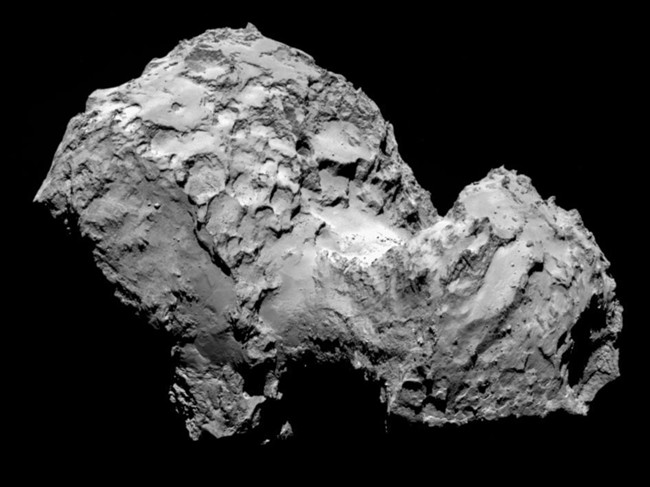Watch above: A day after the Rosetta space probe’s Philae lander touched down on a comet, the scientists behind the mission revealed it didn’t touchdown where it was intended to. Eric Sorensen looks at what went wrong and what happens next.

BERLIN – Europe’s comet lander Philae has come to rest in the shadow of a cliff, posing a potential problem for its solar panels, scientists said Thursday as they published the first image ever taken from the surface of a comet.
The photo shows a rocky terrain, with one of the lander’s three feet in the corner of the frame. It is part of a slew of data that Philae is transmitting back to Earth, indicating that its instruments are working properly, said Jean-Pierre Bibring, the lander’s lead scientist at the European Space Agency.
Before deciding whether to try to adjust the lander, scientists will spend the next day or two collecting as much data as possible while its primary battery still has energy. The lander’s solar panels were designed to provide an extra hour of battery life each day after that, but this may not be possible now.
- Ontario First Nation declares state of emergency amid skyrocketing benzene levels
- ‘Sciatica was gone’: hospital performs robot-assisted spinal surgery in Canadian first
- Do Canadians have an appetite for electric vehicles? Experts are divided
- Nearly 200 fossil fuel, chemical lobbyists to join plastic treaty talks in Ottawa
“We see that we get less solar power than we planned for,” said Koen Geurts of the lander team.
“This, of course, has an impact on our energy budget and our capabilities to conduct science for an extended period of time,” he said. “Unfortunately this is not a situation that we were hoping for.”
The lander scored a historic first Wednesday, touching down on comet 67P/Churyumov-Gerasimenko after a decade-long, 6.4 billion-kilometre journey through space aboard its mother ship, Rosetta. The comet is streaking through space at 66,000 km/h some 500 million kilometres from Earth.
The landing was beset by a series of problems that began when thrusters meant to push Philae onto the comet failed. Then two harpoons, which should have anchored the lander to the surface, weren’t deployed.
READ MORE: European Space Agency releases 1st picture from comet surface
This caused the lander to bounce off the comet and drift through the void for two hours before touching down again. After a second smaller bounce, scientists believe it came to rest in a shallow crater on the comet’s 4 kilometre-wide body, or nucleus.
“We are just in the shadow of a cliff,” Bibring said, adding that photos indicate the cliff could be just a few yards (meters) away. “We are in a shadow permanently, and that is part of the problem.”
Bibring and his colleagues stressed that the data they’ll be able to collect with the primary batteries alone will have made the landing worthwhile.
“A lot of science is getting covered now,” he said, noting that scientists would soon get their hands on a tomography of the comet and data showing whether the matter it is made of is magnetized.
But because the lander is just resting on the comet with nothing but low gravity holding it down, Philae will have to hold off on one of the most important experiments — drilling into the comet to extract some of the material buried beneath the surface.
Scientists want to analyze this material because it has remained almost unchanged for 4.5 billion years, making them cosmic time capsules.
READ MORE: 5 cool things about the Rosetta mission
“Drilling without being anchored and without knowing how you are on the surface is dangerous. We might just tip over the lander,” said Stephan Ulamec, head of the lander operation.
Gravity on the comet is 1/100,000th that of Earth, meaning the washing machine-sized lander weighs just 0.04 ounces there.
Ground controllers will likely wait until the first big batch of data has been collected before attempting to adjust the lander so that its solar panels can catch the sun and charge its batteries.

Communication with the lander is slow, with signals taking more than 28 minutes to travel between Earth and the Rosetta orbiter flying above the comet.
Even if Philae uses up all of its energy, it will remain on the comet in a mode of hibernation for the coming months. In theory it could wake up again if the comet passes the sun in such a way that the solar panels catch more light, said Ulamec.
Meanwhile the orbiter, Rosetta, will also use its 11 instruments to analyze the comet over the coming months. Scientists hope the 1.3 billion euro ($1.6 billion) project will help them better understand comets and other celestial objects, as well as possibly answer questions about the origins of life on Earth.

Comments